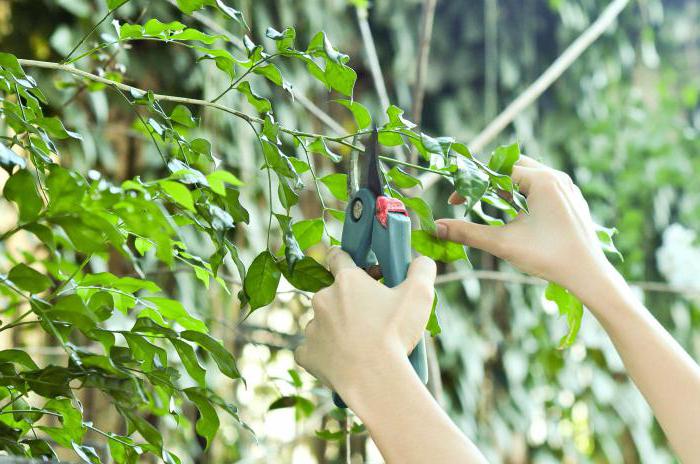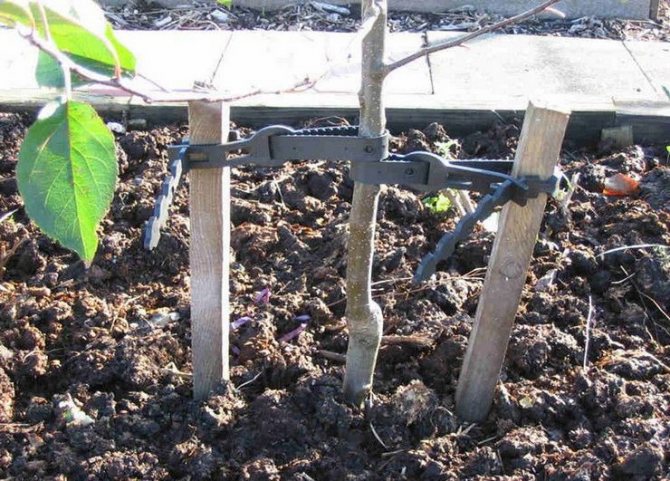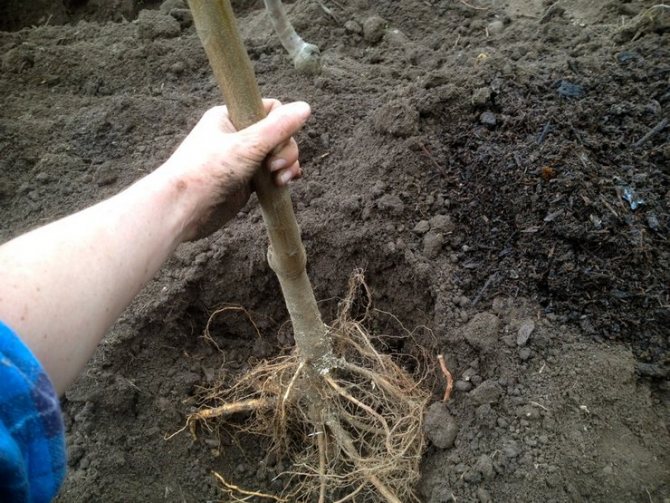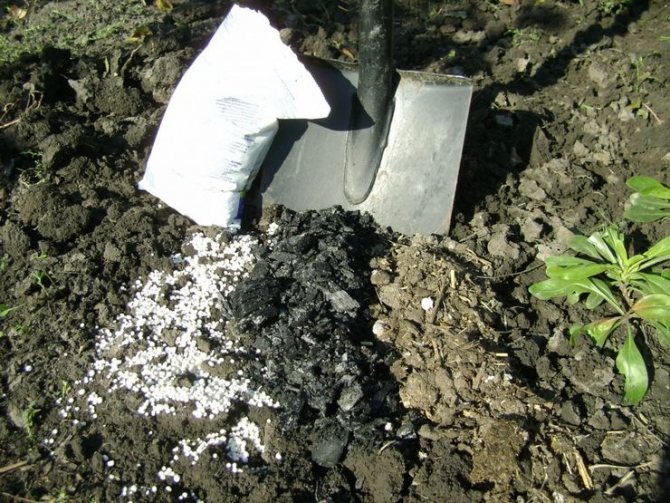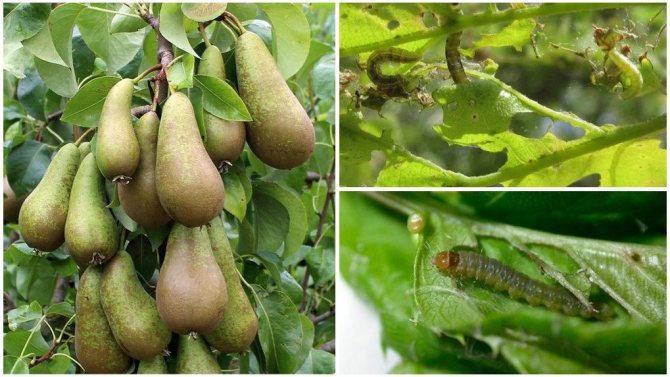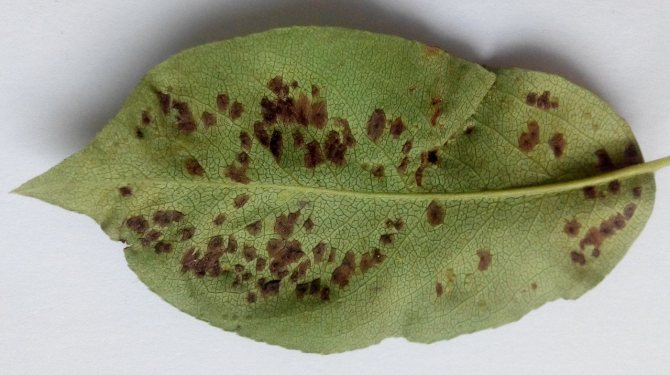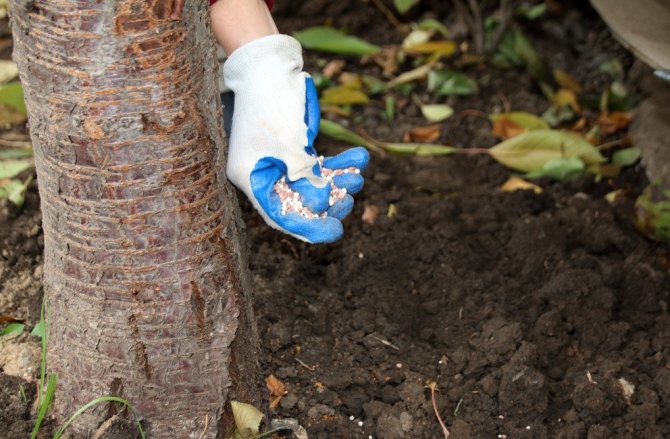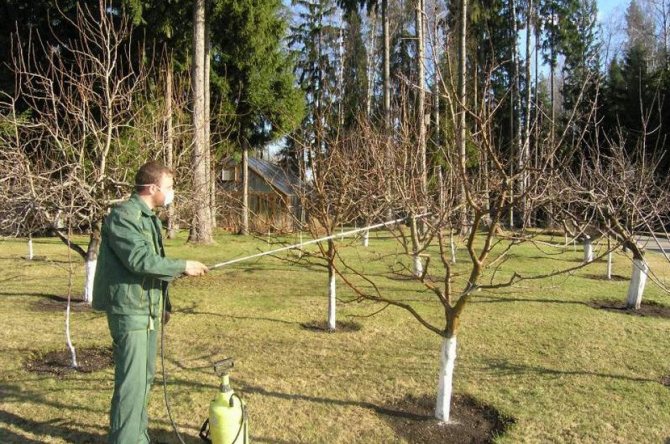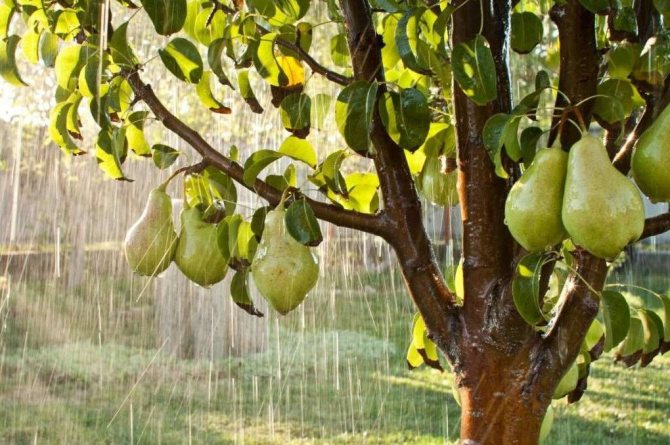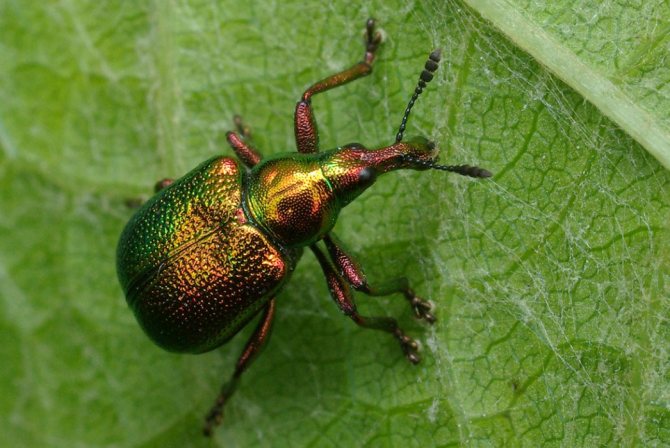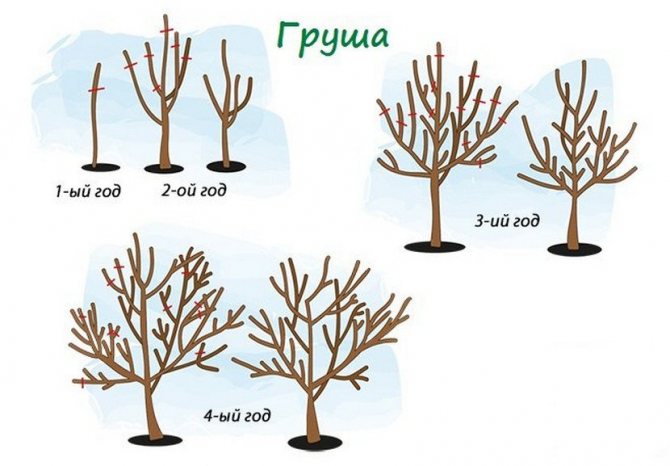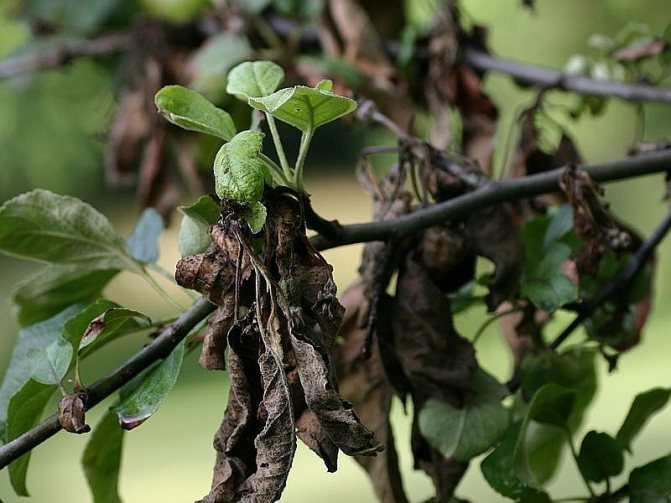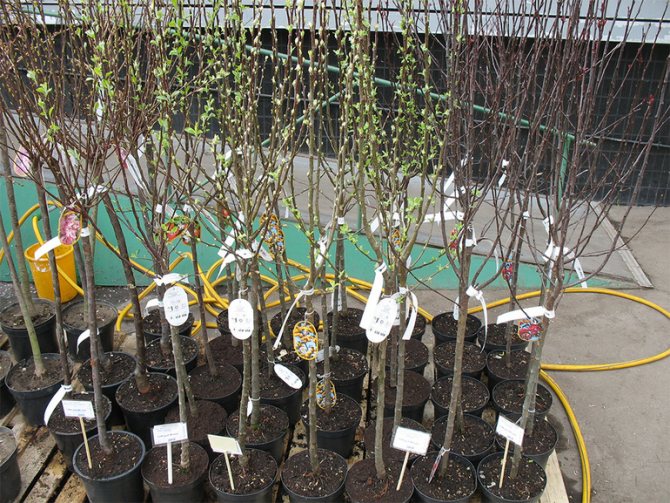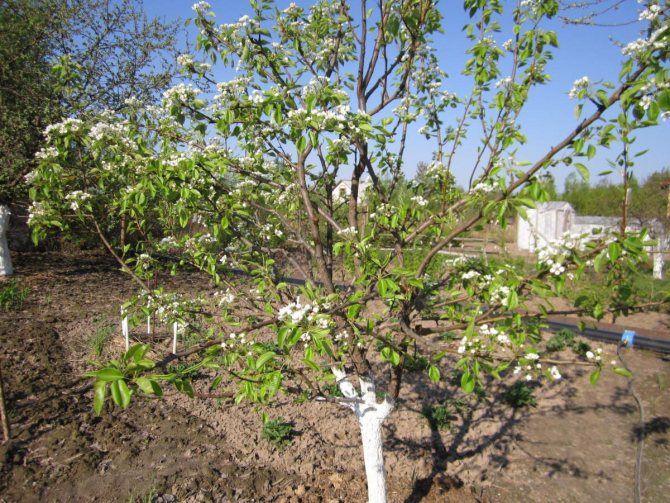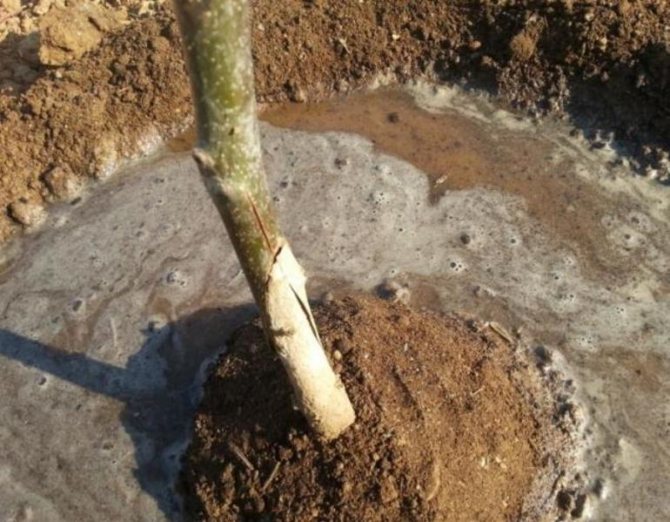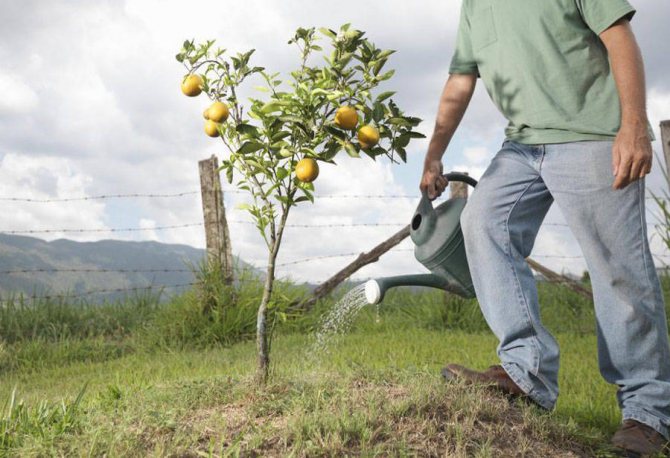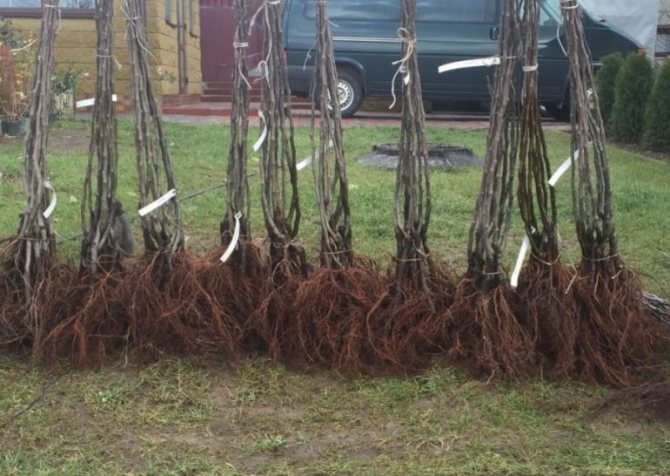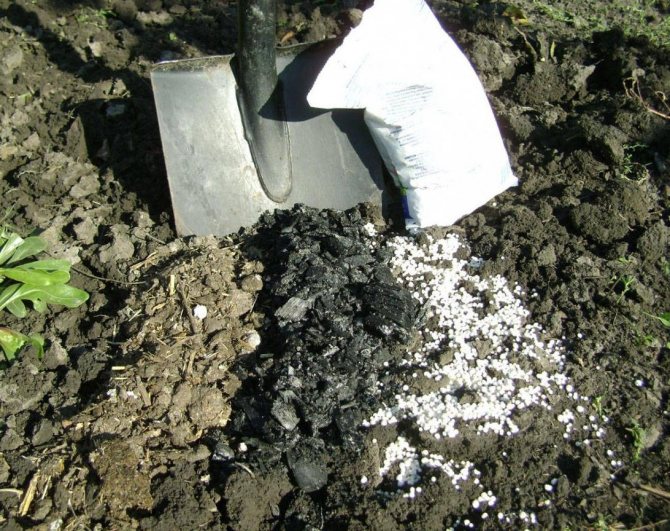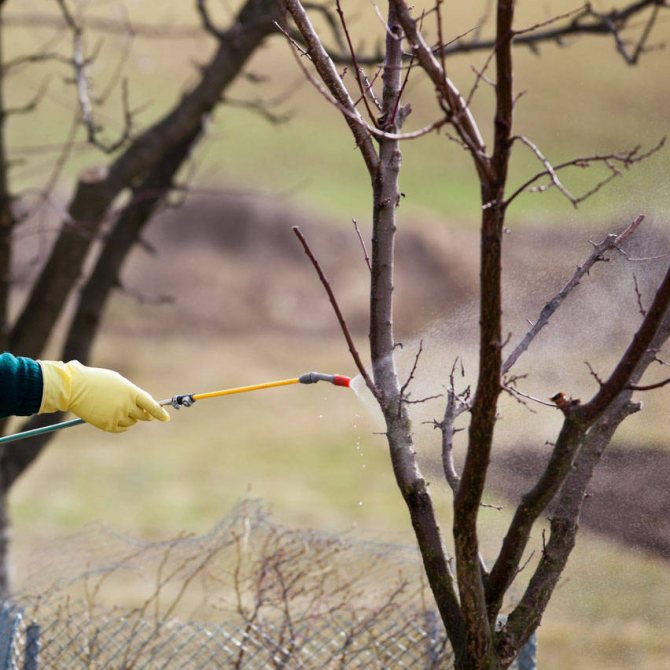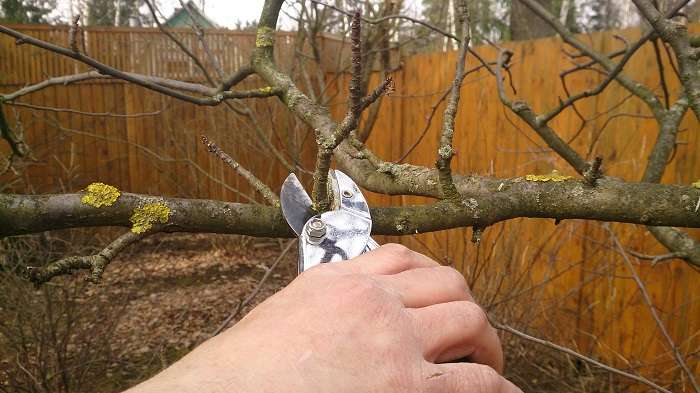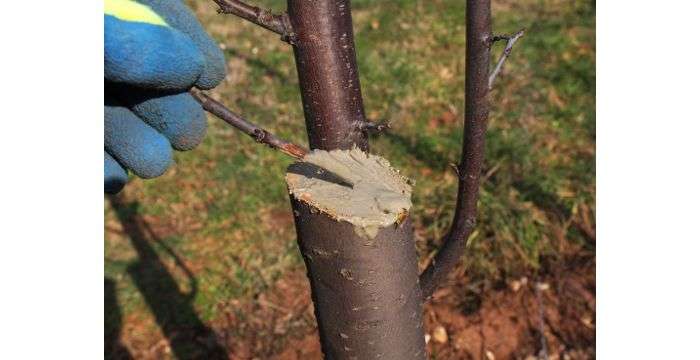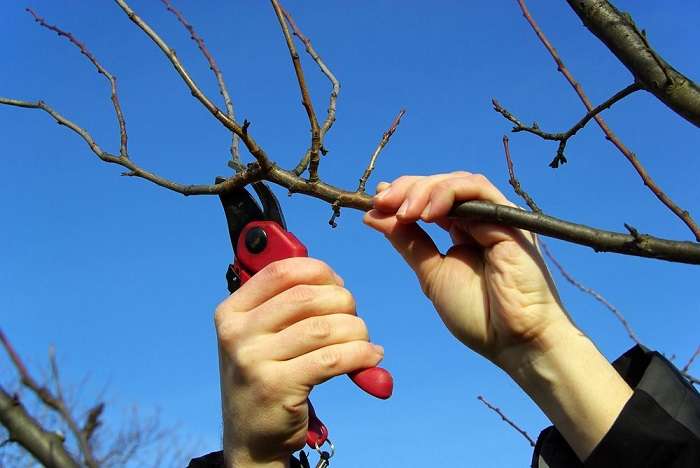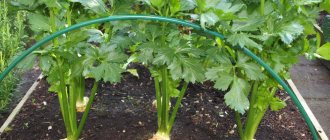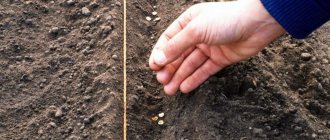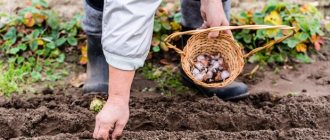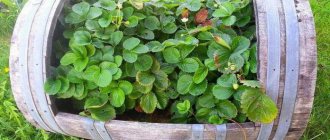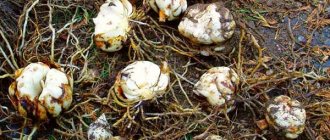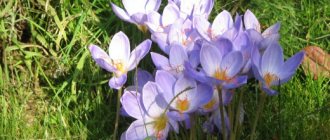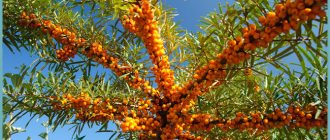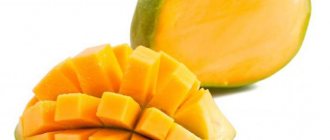Pear is one of the most valuable fruit crops. The palatability of the fruit is high, but the tree belongs to a very demanding crop. Basically, the southern regions of Russia specialize in pear cultivation. This is due to the weak adaptability of the plant to frosty winters. Also, the limitation is imposed by the nature and fertility of the soils of the northern regions, for example, Leningrad, Vologda, Novgorod. The soils for these regions are characterized by a low fertile layer and a poor ability to retain moisture, while having an acid reaction. Thanks to the work of the VIR selection station, several varieties of pears were bred, adapted to such specific climatic conditions.
In the conditions of a short warm period, it was necessary to breed early ripening varieties that have time to give a harvest in a short time. At the same time, they must have good resistance to subzero temperatures in order to avoid traumatizing the tree in winter. Such pears have a smaller fruit size, less bright taste, compared to southern varieties.
Initially, on the territory of the Leningrad Region, varieties were popular, the taste of which was mediocre and satisfactory (Tonkovotka, Dulia Novgorodskaya pear). Later, the most popular were Pushkinskaya, Severyanka, in memory of Yakovlev and Pavlovskaya.
The lack of seasonal alternation of yield is a significant plus. At the same time, the listed varieties are generally suitable only for quick use, since they do not differ in long-term keeping quality. Next, we list the suitable pear varieties for the Leningrad Region.
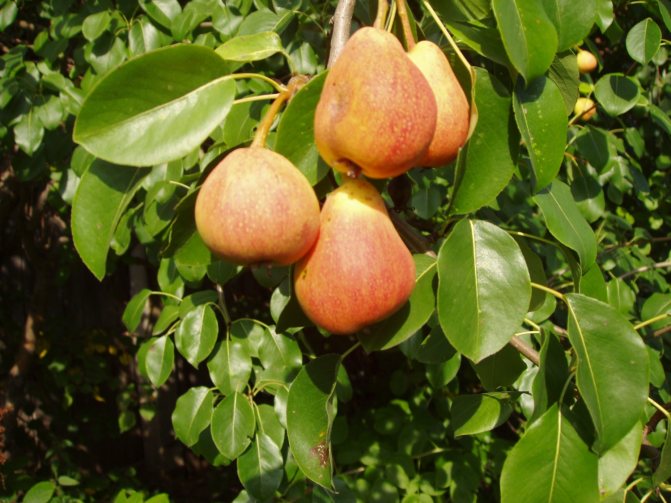
Thin line
Is it possible to plant a pear in the fall. How to plant a pear in the fall: a step-by-step guide
To get the desired result from planting a pear, you should adhere to a number of simple but very important rules.
Choosing the right soil
Pear is a heat-loving plant that loves the sun. With a lack of sunlight, it will not work to get a harvest of sweet fruits - sugars are deposited only under the influence of the sun. In addition, coolness and dampness cause fungal diseases, rot and scab.
In the area where it is planned to plant a tree, groundwater should not approach the surface closer than 2.5 m. Also, melt water should not stagnate on the plot. For a pear, a fertile, loose loam with neutral acidity is suitable.
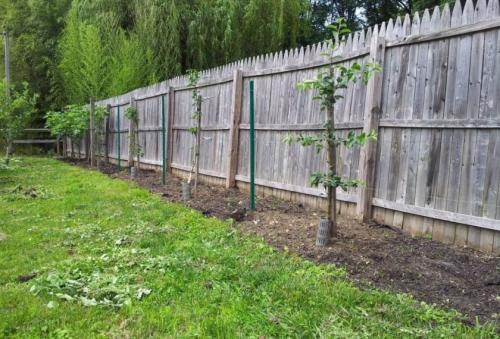

Preparing a pit for planting pears
The landing pit is prepared in advance (20-30 days before planting). When digging, the top layer (30 cm) is thrown to one side, and sand and loam to the other.
The pit should be 60–70 cm deep and 90–100 cm wide. Then the recess is filled with humus, wood ash, superphosphate and soil. Small flecks are made on the walls for root growth.
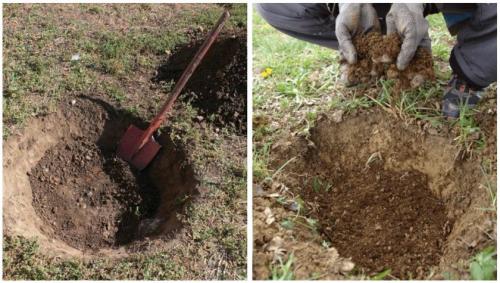

The larger the pit, the better the conditions for adaptation of the seedling will be and the longer they will be provided.
Pear planting technology
Planting a tree is best done together: one holds the seedling and straightens the root ball, and the other covers it with soil (fertile top layer) mixed with fertilizers. In this case, the tree is set at such a level that the neck rises 5 cm above the surface.
You should not deepen the seedling for the following reasons:
- the plant will grow slowly;
- the bark will be covered with lichen and moss;
- the tree will suffer from pests;
- frost resistance will decrease;
- the pear will be susceptible to fungal diseases;
- the foliage will be small, and the branches will dry out.
Important! Planting pears must be completed 15–20 days before the onset of frost. Short-term frosts are not taken into account.
After filling the hole, the soil is trampled down, and a shaft is made around. A hollow should form near the seedling, into which 2-3 buckets of water are poured after planting.
The next day, the area around the seedling is mulched with a layer of up to 10-30 cm. The remaining soil and organic fertilizers are used as mulch. This procedure is necessary to prevent the formation of soil crust and retain moisture. At the end, the tree trunk is tied to a support (stake, pole).
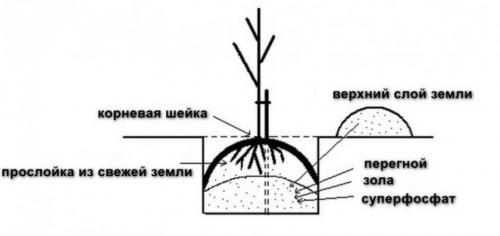

Choosing a place
The peculiarity of pears is that they do not tolerate transplanting well. Therefore, you need to carefully inspect the site, take into account where the tree will be most comfortable and plant it immediately in a permanent place.
"Important! The area must be well lit, level and dry. The soil needs fertile, loosened and medium moisture before planting. "
From the house, barn, cellar and other buildings, the tree should be placed no closer than 3 m, but better further. Several or more pear trees can be planted side by side. This will help them effectively pollinate.
It is required to adhere to these rules:
- Plant a tree in a clearing, perfectly illuminated by the sun, so that there is no shade from the house, other buildings and trees.
- The area must be flat and dry.
- It is required to determine where the groundwater passes. If it is too high and the pear reaches them, then over time the roots will rot and the plant will die.
- The pear does not tolerate drafts well. It is not placed in a windy place.
Pruning pears when planting. Pruning pears in spring video for beginners
Pear pruning is an important procedure for caring for fruit trees. It provides the tree with growth, yield, proper crown formation, and is also an excellent prevention of various diseases, the pathogens of which penetrate inside through damaged branches. In our article, we will consider the types, periods and features of pruning, and also discuss how to properly carry out this procedure.
Pruning apple trees in the fall is critical to maintaining the garden and ensuring good yields. But pruning pears is an equally important and useful procedure, provided it is carried out correctly. Despite the fact that this fruit tree grows rather slowly, improperly growing branches can obscure the light, without which it will quickly begin to wither and may even die. That is why you need to start trimming the pear as early as the next year after planting, and finish only after it dries out.


Systematic pear pruning has a number of benefits:
- the formation of a strong trunk and skeletal branches that will not break from the weight of ripe fruits;
- the ability to evenly distribute moisture and nutrients along the trunk;
- ensuring free access to direct sunlight;
- convenience in spraying and other tree care procedures;
- free access to fruits at the time of harvest.
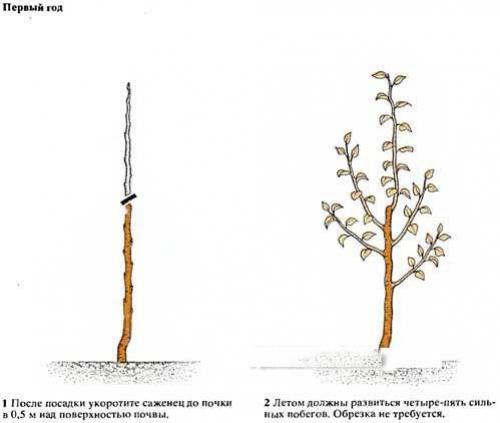

1 year pruning scheme
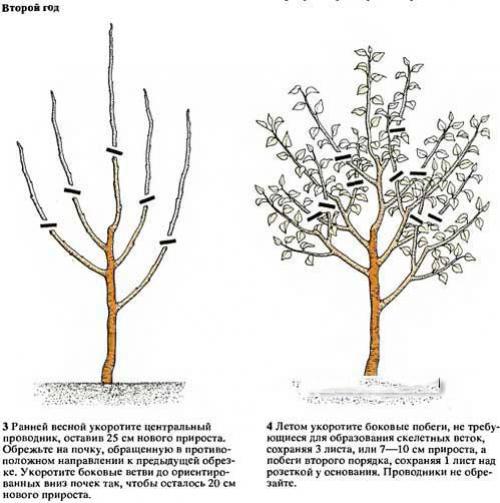

Pruning scheme for 2 years
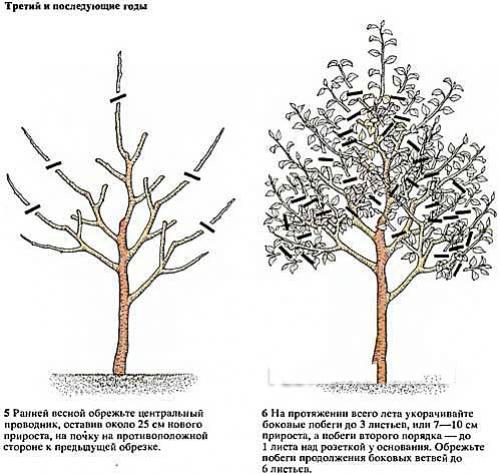

3 year pruning scheme
If the pruning of branches is ignored, then this will lead to the depletion of the plant due to the intensive growth of its branches and shoots, due to which the volume of fruiting will significantly decrease, and after a while it will stop altogether.
However, any kind of pear tree must be pruned correctly. To do this, you need to find out the types and methods of these procedures, the time of year when they are carried out, the basics of circumcision techniques and have all the necessary tools.
The tool used for this procedure must be well sharpened and absolutely clean. This will reduce the risk of infection and make your job easier.
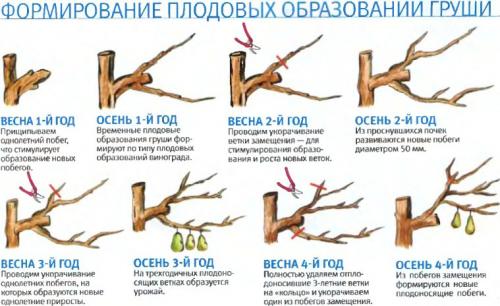

There are 2 types of pruning:
- Pruning - Pruning the annual growth and tops of the branches, which slows the tree upward growth and promotes better branching.
- Thinning - pruning branches at their very base, allowing the sun to penetrate into the crown.
In parallel with this, other, additional work is carried out - garter, tilt, bending of branches, removal of root growth, etc.
As for the purpose of pruning this fruit tree, it can be:
- Forming - for shaping the crown.
- Rejuvenating - to prolong its fruiting period.
- Supportive - essential for the productivity and health of the pear.
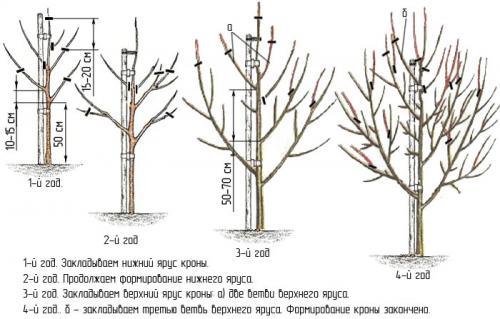

Forming pruning
Regardless of which variety grows in your country house, you will have to correctly carry out all of the above types of pruning throughout the life of the pear.
Choosing a tree
Before buying a seedling, you need to study which varieties are well accepted in the region where the gardener lives? Experienced gardeners advise buying only a suitable plant variety. It is best to choose a strong, with good (no rot, cuts, ulcers, etc.) roots, branched tree.
"Important! The purchase of a seedling must be taken seriously, since the pear will grow on the site for more than 20-30 years. When choosing, it is best to get the healthiest and strongest plant. "
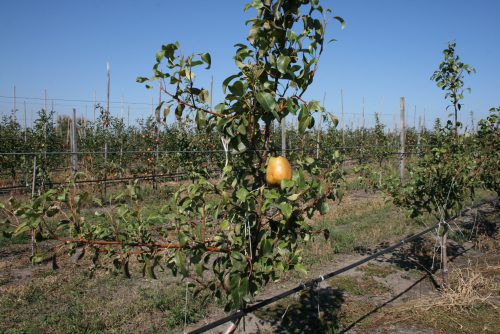

If you want a certain kind of pear, then it is best to go to the nursery for a seedling. A private trader can deceive or incorrectly name a pear variety that grows on his site, sell a stalk infected with a disease. In the market, the main thing is to sell to traders and they often give out one variety after another.
How to plant an apple tree. How to properly plant an apple tree at home
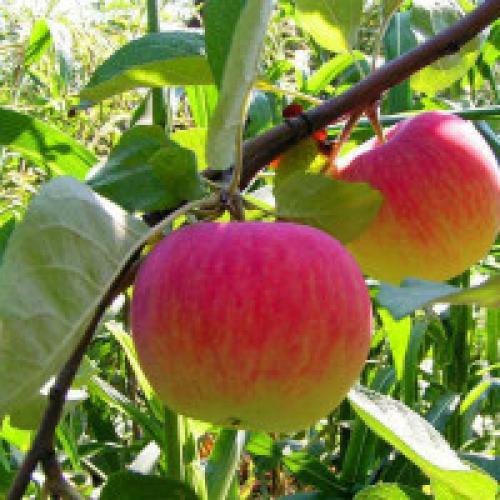

The apple tree is one of the most common horticultural crops in our country. Thanks to the wide variety of varieties, you can grow an apple tree in any climate, and proper tree care will help you get a rich harvest. You will find an overview of popular varieties, the basic rules for planting and caring for apple trees in our article.
You will learn how to choose the right seedlings and plant them in open ground, as well as how to prune an apple tree and protect it from diseases and pests.
Planting an apple tree
To plant an apple tree, you need to choose sunny places, closed from strong winds, and since it blooms in May, it needs to be additionally protected from frost. To do this, you need to choose the right rootstocks to limit the growth of the tree and shape the crown so that it is not too tall. In this case, it can be covered overnight during frost. In addition, there are special varieties that bloom later, when there is no frost.
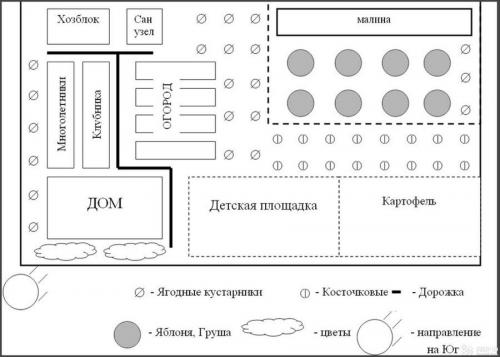

Figure 1. An approximate layout of crops on a personal plot
Apple trees can be planted in an area that is shaded for half the day. However, in more sunny areas, dessert varieties should be placed, and shaded areas should be used for growing species intended for further processing. This is important as the sun directly affects the taste and color of the fruit.
Protection from the wind is necessary because apple trees are pollinated by insects, and in a strong wind they simply cannot collect pollen, and the harvest will be small. If there are only open spaces on the site, they can be fenced with a hedge of dwarf trees or an ordinary board fence. An approximate scheme for the planning of the suburban area and planting is shown in Figure 1.
Time and timing of planting an apple tree
Slightly acidic loam with good drainage is considered the optimal soil, but most varieties develop normally on other soils.
Note: Dessert varieties should only be grown in well-drained soils, and trees intended for growing fruit for further processing can be cultivated on any soil, but the soil should still not be too wet.
In areas with sandy soil, it is necessary to additionally use organic fertilizers, as well as intensively mulch and water the soil.
Soil preparation for planting includes (Figure 2):
- Thorough cleaning of perennial weeds (on a plot of one square meter);
- Application of complex mineral fertilizers;
- Preparing stakes and other planting equipment.
About autumn care
After planting a tree in the fall, you need to continue to water it little by little. On the ground, a crust should not form at the trunk; in order to avoid this, the soil is loosened.
Weeds are removed from the soil. This is done so that other plants do not draw nutrients from the soil, and all fertilizers go to the pear, accelerating its growth.
Taking care of a pear in the fall is easy. For the winter, a young trunk is tied with spruce branches. This will help protect him from mice with hares.
In winter, some owners make an acrylic tent. It helps to protect the seedling from severe frosts. Now every novice gardener understands that planting pears is quite easy even for a beginner to cope with.
How to choose the right place for planting pears. Features of planting operations in different regions
As noted above, for the autumn planting of pear seedlings, such periods are chosen so that at least 3 weeks remain before frost. The spring planting of the culture is performed after the snow melts, when the average daily temperature is set at +5 degrees, but sap flow has not yet begun.
In Russia, the climate and weather conditions in different regions vary greatly, so the timing of spring and autumn planting of pears varies greatly.
In autumn terms
Below are the approximate dates for planting pear seedlings for some regions of the country.
- Moscow region. Planting pears in the fall in the Moscow region and in the middle lane is planned, as a rule, for the period from the third decade of September to October 20-25. Before the onset of the frost period, there is enough time for the seedling to root. The varieties are planted: Moskvichka, Skazochnaya, Allegro, Rognedo, Chizhovskaya.
- Ural, Siberian regions. In these areas with harsh conditions, autumn planting is used quite often. If the seedling survives the first winter safely, the adult tree will acquire good winter hardiness. Autumn in this zone is fleeting, so they try to plant a pear during September. Pear varieties are well suited for this zone: Severyanka, Skorospelka, Taezhnaya, Sverdlovskaya, Lel.
- Leningrad region. In the Leningrad region, weather conditions are difficult to predict, therefore, when choosing a date for autumn planting, you need to carefully monitor the weather. Most often, suitable conditions for planting pears there arise at the end of September and continue until the third decade of the next month. It is advisable to protect the seedlings from the piercing cold winds.
Pushkinskaya
The decision of gardeners to use early pear varieties for the Leningrad Region is quite justified. They allow you to grow a crop of fragrant fruits in a short summer.
Pear Pushkinskaya is a rather powerful tree with a rounded, widely spreading crown. Flowering begins in the early middle periods. The fruits are of medium size, cuboid and yellowish, with a blush color. The pulp of the fruit is sweet and very juicy, with a slight tart flavor. The yield of this variety is above average. The fruits begin to ripen at the beginning of September and remain in maturation for no more than 10 days. The variety is winter hardy.
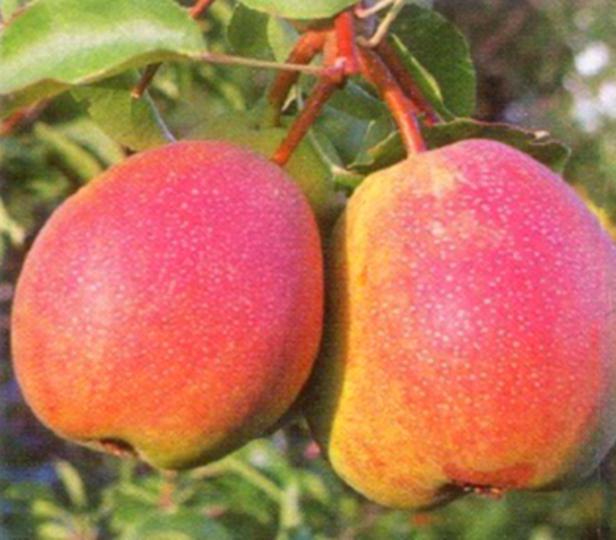

In which month to plant a pear. WHEN TO PLANT A PEAR. LANDING PEARS IN SPRING AND AUTUMN - SECRETS OF SUCCESS.
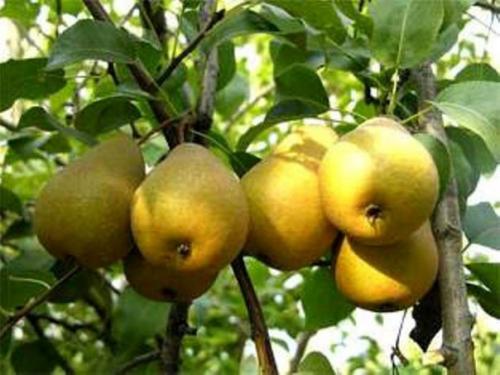

The pear, like the apple tree, belongs to the group of pome crops and belongs to the Rosaceae family. This culture is the second most important and widespread after the apple tree. The winter hardiness of a pear, alas, is less than that of an apple tree, in this regard, its use is limited to warm regions, in the northern regions it is impractical to grow a pear. A pear is a tree with a large number of positive qualities: it is durable, it can give a crop for about 100 years, its crown is pyramidal, that is, it thickens less, and in terms of fertility of the pear one can envy, already in the fifth year it will give the first harvest, and the maximum can reach 100 kg from a tree.Place for planting pears. For planting pears, as a rule, they choose the most illuminated place, sufficiently dry and even. In order for pollination to be complete, several different varieties should be planted on the site, blooming at the same time. The most suitable substrate for the full development of a pear is loose, water and air permeable, capable of retaining moisture in the root layer. The best fruiting can be achieved in nutrient-rich soil. You should not plant a pear in lowlands, in such places, the level of groundwater, as a rule, is located high enough, which, in combination with the cold accumulating in winter in such places, can negatively affect the plant. The pear does not really like shading, so when placing a seedling on the territory, try to allocate a place for it, stepping back from the summer cottages at least 3 meters. When to plant a pear. Planting is usually carried out in two years, and can be planted both in spring and autumn. Most often, a pear is planted in the fall, in September, but if you decide to plant a pear in the spring, then try to keep within before the beginning of May (before bud break - in this case, planting a pear in the spring is possible). In the southern regions, where spring comes very early, it is better to plant a pear in the fall. The advantages of autumn planting in these regions are obvious - it contributes to the faster formation of adventitious roots due to the content of a large amount of moisture in the soil, and this has a beneficial effect on plant survival and is positively reflected in growth in the new season. How to plant a pear correctly - the secrets of success. Directly planting the seedling is carried out in the planting holes, which are dug based on the size of the root system, the roots should be freely located in the hole without bends and creases. For faster survival of the seedling in a new place, it is necessary to add nutritious soil mixed with humus, superphosphate and potassium sulfate to the hole. On dense soils, a bucket of coarse river sand can be added to the base of the planting hole. Immediately before planting the pear, a wooden peg, about half a meter high, is driven in near the hole. The peg must be located on the south side, which will prevent the seedling from overheating in the summer from sunburn in the early spring period. Among other things, the peg will help maintain the stability of the still not strong seedling under the gusts of the wind, in the first year of life. After the peg is installed and the mixture is ready, you need to pour it into the hole so that a small mound forms. The root system of the seedling is placed on the mound and covered with soil so that the root collar ends up being about 6 cm above the soil level. In order to prevent voids from forming between the roots during planting, the seedling, holding by the trunk, is shaken several times, after which the soil in the near-trunk circle is compacted. When the seedling is reliably covered with soil and it is compacted, a small hole with a diameter of 20 -25 cm is made around the tree, it is necessary for watering. When watering is done, the hole should be mulched with peat or humus to maintain soil moisture. Pear varieties for different growing areas: The best pear varieties for the Moscow region and the Central region - Chizhovskaya, Lada, Kafedralnaya, Pamyat Zhegalova, Nadyadnaya Efimova, Moskvichka, Veles, Pamyati Yakovlev, Bryanskaya beauty and Petrovskaya. For the Central black earth region, the August dew, Skorospelka from Michurinsk, Severyanka red-cheeked, Allegro, Memorial, Krasavitsa Chernenko, Marble Alyonushka, Fairy are ideal. For colder regions with long winters, the varieties Fields, Lida, Tema, Olga, Vnuchka, Dibrovskaya, September fun, Beta, Arabka will be very useful.
Preparing a pit for a seedling
Most gardeners do not bother themselves, they just dig a hole, put a seedling in it and cover the roots with earth.This approach is justified on fertile soils, but it is better not to be lazy and prepare the place according to all the rules:
- The diameter of the pit is about 70 cm, the depth is up to half a meter.
- The top layer of soil is thrown off to one side, the bottom to the other.
- If the soil is clay, then the hole is deepened, and sand is poured onto the bottom, preferably river sand.
- On poor soils, a layer of humus or peat is made.
- A good result is given by the introduction of ash.
The top layer of the excavated soil is also mixed with humus (sand) and ash, it will then need to be poured into the hole with a slide .. In the future, it will serve as the basis on which the underground part of the seedling will be placed.
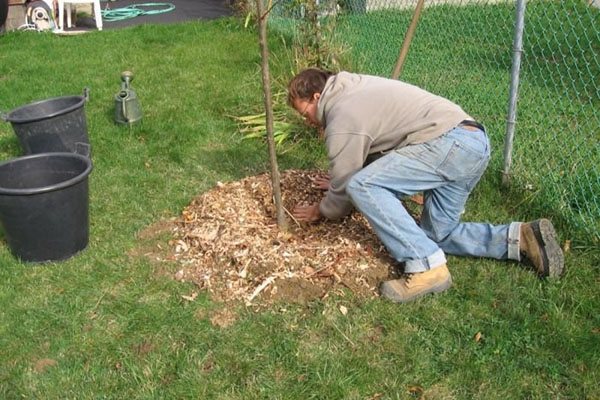

Observance of these points will help the tree to take root better and safely endure the winter. Such training is especially relevant in regions with a harsh climate.
Site selection
To know how to plant a pear correctly, you need to take into account many factors related to the illumination of the site, soil composition, predecessors, proximity to other plants in the garden.
Illumination of the place
A pear is a culture that is quite demanding on light, so you need to choose an illuminated area for it. The more intense the light, the greater the yield of juicy, sweet fruits. Unshaded places protected from winds are allocated for seedlings.
If the planting is carried out in a new place, where there are still no plantings and buildings, elevated places with the occurrence of groundwater at least 3 meters to the soil surface are allocated for it.
It is important to remember that the pear is a tall tree that gives long shade on sunny days. Therefore, it is usually placed along the northern fence of the site so that it does not obscure other plants.
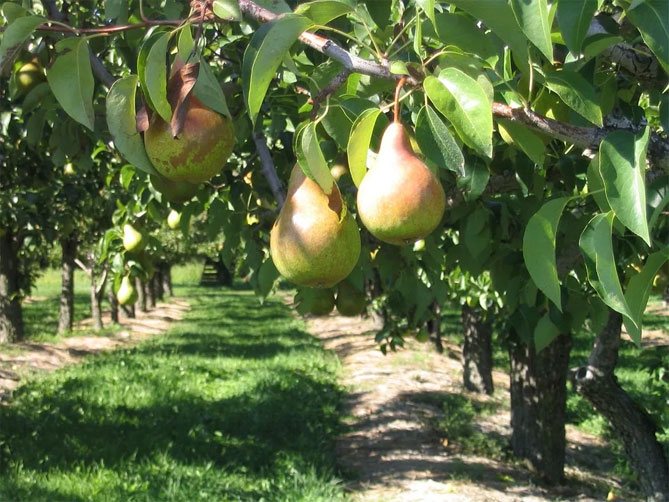

Neighborhood with other cultures
The pear grows well next to the apple tree, mountain ash. Unfavorable neighbors for her are:
- cherry plum;
- viburnum;
- plum;
- cherry;
- lilac;
- apricot;
- sweet cherry;
- gooseberry;
- raspberries.
What soils are suitable
For pear trees, loamy and clayey soils are most preferred. The soil should be neutral, fertile, sufficiently permeable to air and moisture. Poor sandy, as well as floating clayey soils are unsuitable for the cultivation of this crop.
Important! It is undesirable to place the pear too close to the fence, other tall trees, buildings.
Pests
A dangerous pest is a pear leaf flap or a honeydew. It is a yellowish or gray insect up to 3 mm long. It sucks the juices from the branches, leaves, which are covered with a transparent liquid. Spraying with Aktara insecticide helps.
The pear gall mite infects the leaves of the plant. Swellings of brown and black colors appear on them. It is fought with mitak acaricide and colloidal sulfur.
The winter moth affects shoots, buds, and leaves. She hibernates in cocoons in the soil. Dig up or replant soil effectively before frost.
Rodents cause trouble. Hares and mice gnaw on young bark and wood. For prophylaxis, the trunk is wrapped in burlap, plastic mesh or spruce branches. The bark of the trunk is coated with clay with a mullein in a 1: 1 ratio, diluted with water to the consistency of sour cream. The solution has a strong unpleasant smell and taste, which scares off rodents.
In memory of Yakovlev
A gorgeous and very popular pear. For the Leningrad region, the varieties Olivier de Serre and Tema were crossed by breeders S.P. Yakovlev, Ya.S. Nesterov and P.N. Yakovlev. The result was this early autumn variety.
The tree is not tall, it grows quickly. The crown is spherical. The branches grow at an angle to the trunk, a little later, annelids appear. The crown is smooth, sometimes flaky, gray in color.
Shoots initially have a light brown tint, often covered with lenticels and thorns. The kidneys are conical in shape, smooth, slightly bent. Leaves are leathery, ovoid, dark green in color. Their top is twisted, attached to a rather long petiole. The flowers are white, six in inflorescences, have separate petals.
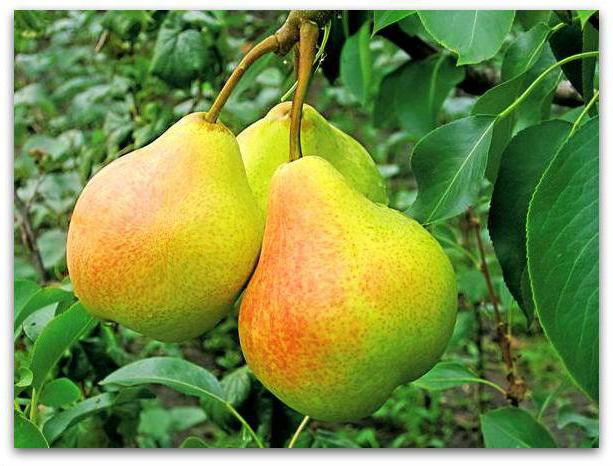

The fruits are wide pear-shaped or bluntly pear-shaped, with a smooth and shiny skin. Weight reaches 150 g. Painted in light yellow or golden yellow. The peduncle is curved, long. The fruits can stay on the branches for a long time.
Ripen in early September, perfectly stored until December. The pulp is creamy or white, semi-oily, juicy and sweet. Fruiting usually begins in the third year after planting. The yield increases annually. At the age of seven, the tree gives up to 20 kg of pears.
Useful advice from experienced gardeners
Experienced gardeners give practical advice to novice summer residents:
- Only zoned varieties should be chosen. They will quickly take root and acclimatize on the site.
- You should not take seedlings with unripe roots. They usually freeze over the winter.
- Too developed seedlings with lush foliage should not be taken. They may have an undeveloped root system, and the seedling itself is overdried, because the main loss of moisture goes through the leaf plate.
- When planting, you cannot use nitrogen-containing fertilizers. When planted in autumn, they will simply destroy the tree.
- The soil at the bottom of the pit must be loosened.
- We must protect the root system. It should not come into contact with potash fertilizers.
- Remove weeds. This serves as an excellent prevention of the appearance of aphids.
- Try to choose the right neighbors. The proximity of rowan, apple, conifers will be useful. It is not recommended to grow pears next to cherries, plums, raspberries and currants.
It will be useful for you to learn about the features of transplanting pears in the fall to a new place.
The choice of the season for planting pears is not a fundamental point - each period has its own pros and cons. It is much more important to choose the right place, properly prepare the soil and provide decent care. Then the tree will surely delight you with a generous, juicy harvest.
Unfavorable neighbors for culture
The compatibility of fruit crops has been known for a long time. If you pick up an unfavorable neighbor, then he will oppress, negatively affect the fruiting of another tree. And if you plant a number of neutral neighbors, then their cultivation and fruiting will be successful.
You should not plant a pear with:
- plum;
- cherry plum;
- cherries;
- viburnum;
- apricot;
- barberry;
- lilac.
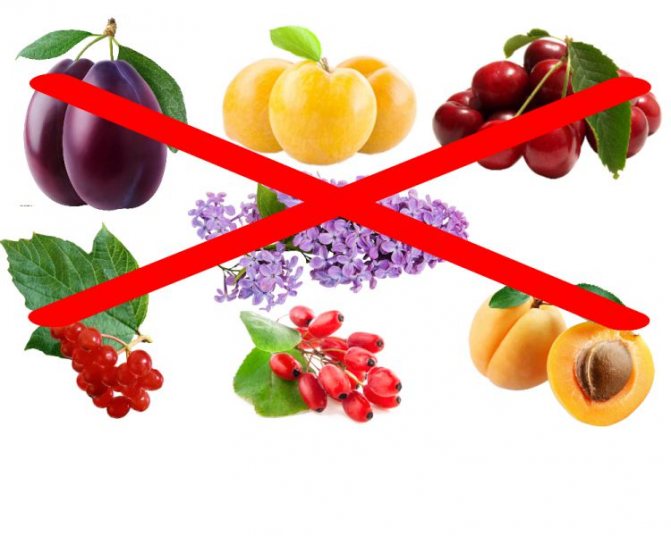

Early Pavlovsk
Another pear for the Leningrad region. The varieties suitable for this region are characterized by increased frost resistance. This variety is no exception. The tree has a wide pyramidal crown. Flowering takes place in the mid-early period. The fruits are rather small, light green, with a blush. The pulp is tender, sweet, of good taste, juicy.
It is a hardy and productive variety. The first fruits can be obtained at the end of August. They do not differ in keeping quality (they are stored for no more than five days).
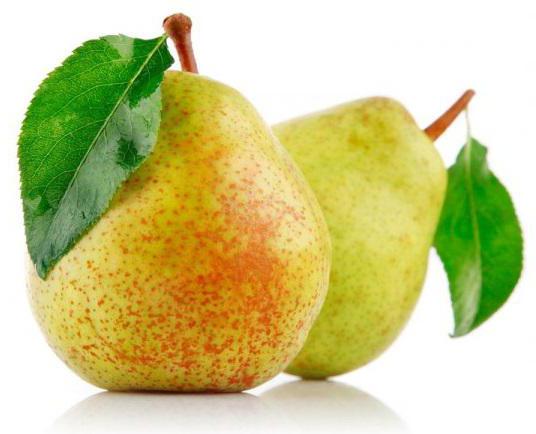

Common diseases
The most common diseases that pear trees can suffer are:
1) Scab. It actively begins to develop in the spring. A brownish-greenish bloom appears on the leaves, and even green leaves begin to fall off.
2) Fruit rot. Gray-brown rot circles appear on the pear, it is transmitted by air, infecting other trees.
3) Rust. Refers to fungal diseases. Stains appear on the leaves that resemble rust.
4) Powdery mildew. Almost the entire plant is affected: flowers, shoots, leaves, buds. It begins with the appearance of a mealy-dirty plaque, then it turns brown, which leads to the formation of black dots.
5) The sooty fungus appears as a black coating on the fruits and leaves of the pear.
In summer, trees are treated with urea or copper sulfate for diseases. But you should remember the golden rule: it is better to warn any disease or the appearance of pests than to fight them later, and immediately start treatment with the appearance of the first signs.

